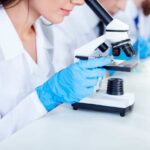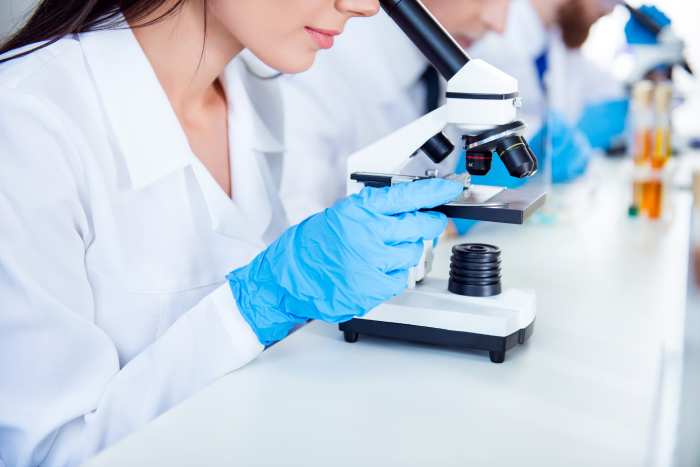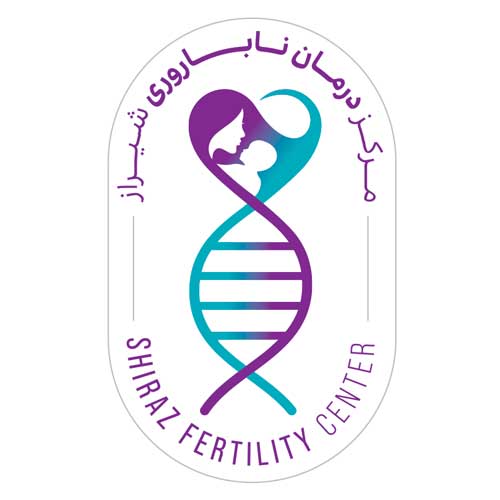
Andrology Laboratory of Shiraz Infertility Treatment Center
In the Andrology Laboratory section, primary and advanced evaluation of semen and sperm, as well as various methods of sperm preparation and washing for assisted reproductive techniques, including:
- IVF
- IUI
- ICSI
- TESE
are performed. Other activities of this section include freezing and storing sperm.

Semen Analysis in the Andrology Laboratory
Semen Analysis: Generally, sperm are produced in the testicles, stored and become motile in the epididymis. Semen consists of two cellular and plasma parts, of which the cellular part constitutes about 10% of the semen volume and includes spermatogonia, spermatocytes, spermatozoa, white blood cells, and so on.
The plasma portion of semen is derived from secretions of accessory sex glands, including the prostate gland, seminal vesicles, Cowper’s glands, and epididymis. It constitutes approximately 90% of the semen volume. During ejaculation, the plasma portion is added to the cellular portion, resulting in the dilution of semen. Semen analysis is not only the basis of laboratory evaluation for infertile men but also helps in diagnosing the severity of male infertility.
Due to natural variations in sperm quality among individuals, the results of the initial semen sample may not accurately reflect the individual’s ejaculatory status. Therefore, at least two samples are required for the initial evaluation of male infertility. If the first sample is abnormal, a second sample is collected after a minimum interval of 4 weeks. Repeating the sampling, with an abstinence period of 2 to 7 days, can provide an accurate diagnosis of semen parameters.
semen collection method
The duration of sexual abstinence is one of the factors related to changes in semen quality. Therefore, the minimum and maximum abstinence time is considered to be about 2 to 7 days. If this time is shorter, the semen volume and sperm concentration will be lower than the desired level, and a longer time may also have a negative effect on sperm motility. Sampling should be done at the laboratory and without stressful conditions. If a second sample is needed, the number of days of abstinence should be constant.
Semen quality depends on how the sample is collected. Sometimes, the individual cannot deliver sperm on the specified day due to stress and anxiety. In such cases, in addition to helping the individual to relax, if the partner has not undergone surgery, they can help their partner to provide a sample in a private and calm environment. If it is not possible to collect a sample at the laboratory, the donor can collect the sample at home, adhering to the sample container storage conditions. The time from sample collection to delivery to the laboratory should not exceed 1 hour. The time from sample collection to examination should also not exceed 3 hours. Sometimes, the use of Viagra (Sildenafil) is also recommended due to its lack of negative effects on sperm quality. As a last resort, if unsuccessful, electroejaculation, sperm aspiration from the epididymis (PESA), or testicular biopsy (TESE) is performed.
Sperm sample is collected by masturbation into a specimen container in the presence of the partner. The specimen container is sterile, wide-mouthed, glass or plastic, with a lid and free of toxic substances so as not to negatively affect the quality of the semen. Complete information about the sample volume, abstinence time, and method of sample collection is recorded. The donor’s information, including the full name of the partner and the donor, date of birth, time and date of sample collection, is written on it.
The container holding the sample can be stored at a temperature between 20 and 37 degrees Celsius. Samples may contain dangerous infectious agents such as HIV, hepatitis virus, herpes, and others. Therefore, adhering to safety and hygiene measures in the laboratory is essential.
Semen analysis is performed after liquefaction, which typically takes 30 to 60 minutes after ejaculation. Longer periods can affect sperm quality due to temperature changes and dehydration. Generally, semen analysis is performed in two ways: general and specific. In general evaluation, macroscopic examination of the semen and microscopic evaluation of sperm parameters are performed. Specific evaluations include biochemical analysis of semen, determination of sperm DNA fragmentation, special staining, 4MACS, FACS, electrophoresis, and SCSA-TUNEY.
Essential guidelines for preparing a semen or sperm sample
- Ejaculate 2-3 days prior to the egg retrieval procedure and do not ejaculate again until after the procedure.
- You should get sufficient rest and eat a balanced diet the night before.
- You should be present at the center on the morning of the egg retrieval procedure to provide a semen sample.
- The sample container must be labeled with a typed label from the center's reception. Containers obtained from outside the center are not acceptable.
- Do not use any lubricants, water, or other substances when providing the sample as they can damage the sperm.
- If you have a fever, are taking any medications, or using any illicit drugs, you must inform the embryology department.
- Even if you have frozen sperm, you still need to provide a fresh sample as fresh samples are preferable to frozen ones.
- If you have any difficulty providing a sample for any reason, you must inform the embryology department so they can provide the necessary guidance.
What is the recommended abstinence period before collecting a semen or sperm sample?
The recommended abstinence period is generally between 2 and 7 days.
Does taking azithromycin 20 days before IVF have a negative impact on male sperm?
No, as the duration of this medication is short, it should not be a problem.
